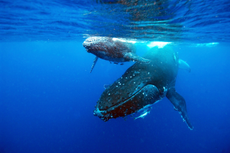Cocaine Bear and other intoxicated critters: the ‘true-ish’ story behind US box-office hit
The ‘horror-comedy’ took $23m on its opening weekend despite being panned by critics

Offbeat movie Cocaine Bear, which follows an American black bear’s cocaine-fuelled rampage, has proved to be an unexpected hit at box offices across the US.
“Universal’s horror-comedy… blew past box office projections”, said Variety, earning an impressive $23m from 3,534 North American cinemas on its opening weekend, and ranked second at the global box office, behind only Disney/Marvel’s Ant-Man and the Wasp: Quantumania.
Directed and produced by Pitch Perfect’s Elizabeth Banks, Cocaine Bear is “literally an entire film about a bear that goes on a mad rampage after ingesting a load of cocaine and it sounds absolutely wild”, said Cosmopolitan. But while cinema-goers might rightly be “a little sceptical at first”, early viewers have been “loving” the “truly chaotic” film.
Subscribe to The Week
Escape your echo chamber. Get the facts behind the news, plus analysis from multiple perspectives.

Sign up for The Week's Free Newsletters
From our morning news briefing to a weekly Good News Newsletter, get the best of The Week delivered directly to your inbox.
From our morning news briefing to a weekly Good News Newsletter, get the best of The Week delivered directly to your inbox.
The ‘true-ish’ story behind the film
The film is “partially based on true-ish events”, said Morning Brew, taking inspiration from a 1985 incident in which a drug dealer attempted to smuggle $15m worth of Colombian cocaine into the United States.
The dealer, a former narcotics officer named Andrew C. Thornton II, “opened his parachute too late”, said The Washington Post, after dropping 75lb of cocaine from a plane along the Georgia–Tennessee border.
It sent the 40-year-old into a “free fall from thousands of feet” and ultimately crashing into a backyard in Knoxville, “instantly killing” the dealer who was found wearing “a bulletproof vest, night-vision goggles and Gucci loafers”.
Months later, authorities discovered that a 175lb bear had found one of Thornton’s bags of cocaine and started eating it. The bear died “of what the coroner described as a stomach ‘literally packed to the brim with cocaine’”, creating a local legend that would eventually form the basis of the Cocaine Bear film.
What the critics said
The movie hasn’t exactly been a smash hit with UK film critics. The Telegraph gave the film one star, calling it an “asinine ursine romp” that proved to be a “Class A disappointment”, adding that it “doesn’t so much insult its viewers’ intelligence as actively libel it”.
The BBC’s Nicholas Barber gave the film a more generous two stars, but said viewers are likely to find themselves wishing the film could fulfil the “gonzo potential” promised by its “in-your-face title”. This “strangely timid” movie quickly “loses momentum”, said Barber.
The film has won more acclaim online, however, with Twitter users praising its offbeat subject matter and casting.
“Thanks to a super-funny ensemble cast, a funnier script, and great direction from @ElizabethBanks, #CocaineBear is a f**king hit. This movie is absurd in all the right ways & just flat-out funny as hell. Long live Cocaine Bear & above all, long live Ray Liotta,” wrote one user.
Another Twitter user wrote that Cocaine Bear “is exactly what you’d expect it to be, dumb fun!” Producer Steve Barton wrote that Cocaine Bear was his “favourite movie of 2023” and that he “loved every second”.
Stoned raccoons and other intoxicated critters
The Cocaine Bear “is not the only animal that has gotten into trouble and eaten something they shouldn’t have” of late, said the Daily Mail. And in the wake of the film’s release, wildlife experts have shared their encounters with intoxicated animals with The New York Times.
Gibsons Wildlife Rehabilitation Center, in Gibsons, British Columbia, took in a “dazed raccoon” after it was discovered in a back garden in 2018. Laboratory testing revealed the animal had “recently ingested marijuana and benzodiazepines”.
The rescue centre took in the raccoon until he had recovered from his drug-fuelled daze. “Suddenly he was alive and, you know, [he was like]: ‘Let me go home.’ So we released him,” said co-founder Irene Davy. She added that the animal was likely to have eaten edibles or a discarded end of a joint left in rubbish.
Vets in the US have also warned that they are seeing more cases “in which dogs have gobbled down edibles and discarded marijuana” in areas where the drug has been legalised, added the paper.
But humans “are not always the source of intoxicants”. Think Wild Central Oregon, which runs a wildlife hotline and hospital, regularly treats small birds such as cedar waxwings after they have become intoxicated from eating large amounts of fermented berries. “They look pretty wobbly,” said Molly Honea, and many “end up striking windows”.
Honea said that the treatment was to “stick them in the oxygen tank and get them rehydrated” before releasing the birds back into the wild.

Continue reading for free
We hope you're enjoying The Week's refreshingly open-minded journalism.
Subscribed to The Week? Register your account with the same email as your subscription.
Sign up to our 10 Things You Need to Know Today newsletter
A free daily digest of the biggest news stories of the day - and the best features from our website
Sorcha Bradley is a writer at The Week and a regular on “The Week Unwrapped” podcast. She worked at The Week magazine for a year and a half before taking up her current role with the digital team, where she mostly covers UK current affairs and politics. Before joining The Week, Sorcha worked at slow-news start-up Tortoise Media. She has also written for Sky News, The Sunday Times, the London Evening Standard and Grazia magazine, among other publications. She has a master’s in newspaper journalism from City, University of London, where she specialised in political journalism.
-
 Today's political cartoons - December 2, 2023
Today's political cartoons - December 2, 2023Cartoons Saturday's cartoons - governors go Gotham, A.I. goes to the office party, and more
By The Week US Published
-
 10 things you need to know today: December 2, 2023
10 things you need to know today: December 2, 2023Daily Briefing Death toll climbs in Gaza as airstrikes intensify, George Santos expelled from the House of Representatives, and more
By Justin Klawans, The Week US Published
-
 5 hilarious cartoons about the George Santos expulsion vote
5 hilarious cartoons about the George Santos expulsion voteCartoons Artists take on Santa versus Santos, his X account, and more
By The Week US Published
-
 The week's good news: Nov. 30, 2023
The week's good news: Nov. 30, 2023Feature It wasn't all bad!
By Catherine Garcia, The Week US Published
-
 Inside the rocky marriage of Priscilla Presley and Elvis
Inside the rocky marriage of Priscilla Presley and ElvisUnder the Radar Rock and roll legend’s former wife praises Sofia Coppola’s new biopic
By Keumars Afifi-Sabet Published
-
 How Burning Man descended into chaos
How Burning Man descended into chaosUnder the Radar Torrential rain leaves thousands of revellers stuck at Nevada festival
By Chas Newkey-Burden Published
-
 Princess Diana’s death in The Crown: how accurate is the Netflix series?
Princess Diana’s death in The Crown: how accurate is the Netflix series?Under the Radar The controversial show is returning for sixth and final season later this year
By Felicity Capon Published
-
 Michael Parkinson: five best interviews by star presenter
Michael Parkinson: five best interviews by star presenterUnder the Radar ‘King of the chat show’ Parky has died aged 88
By Harriet Marsden Published
-
 The Beanie Bubble: the true story behind fallen toy empire film
The Beanie Bubble: the true story behind fallen toy empire filmUnder the Radar New release depicts rise and fall of 1990s stuffed plushy phenomenon
By Harriet Marsden Published
-
 The story behind Sinéad O’Connor’s iconic Saturday Night Live performance
The story behind Sinéad O’Connor’s iconic Saturday Night Live performanceUnder the Radar Singer ‘stepped into culture-war infamy’ after tearing photograph of the Pope live on air
By Chas Newkey-Burden Published
-
 Why police have reopened the Tupac Shakur murder case
Why police have reopened the Tupac Shakur murder caseUnder the Radar House near Las Vegas is searched as police hunt killer of the famous rapper nearly 30 years on
By Felicity Capon Published










